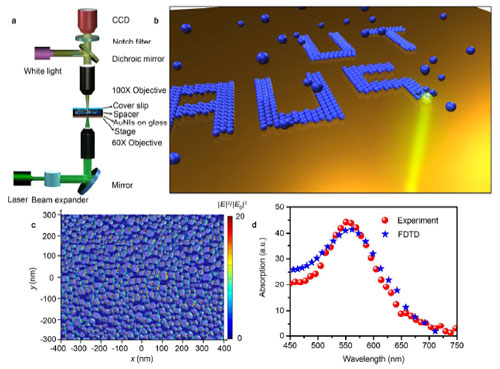| Posted: Dec 22, 2015 | |
Nanotechnology in a bubble |
|
| (Nanowerk Spotlight) Bubble-pen lithography (BPL) is a novel optically controlled nanofabrication technique that can be widely applied to pattern colloidal and biological particles on substrates in order to build functional optic, electronic, and magnetic devices. | |
| "In BPL, an optically controlled microbubble is generated to capture and immobilize colloidal particles on the plasmonic substrates through the coordinated actions of Marangoni convection, surface tension, gas pressure, and substrate adhesion in the substrate-bubble-solution system," Yuebing Zheng, Assistant Professor of Mechanical Engineering and Materials Science & Engineering at the University of Texas at Austin, tells Nanowerk. "The irradiation of a plasmonic substrate with a focused laser beam at the plasmon resonance wavelength generates a microbubble at the substrate-solution interface. Due to the plasmon-enhanced photothermal effects, the bubbles of variable sizes can be generated at a significantly reduced power." | |
| With this new lithographic technique, the researchers can generate bubbles down to 1 µm in diameter, which are much smaller than the microbubbles (diameter in the range of 50-100 µm) commonly used in microfluidic devices for manipulation of particles. The smaller bubbles provide an enhanced patterning resolution. | |
| The larger bubbles limited the patterning resolution while the high laser power that was used in previous techniques could change the particles’ properties or even damage the particles. | |
 |
|
| Working principle of BPL. (a) An overview of the experimental setup for BPL. (b) Schematic illustration of the pattern-writing process using an optically controlled microbubble on a plasmonic substrate. The small blue spheres are colloidal particles. (c) An overlay of scanning electron microscopy (SEM) image and simulated electric field distributions of quasi-continuous Au nanoislands (AuNIs). (d) Simulated and experimental absorption spectra of the AuNIs substrate. (Reprinted with permission by American Chemical Society) (click on image to enlarge) | |
| The team has reported their findings in the December 17, 2015 online edition of Nano Letters ("Bubble-Pen Lithography"). Other researchers working on this project include Dr. Linhan Lin, Xiaolei Peng, Zhangming Mao, Wei Li, Maruthi N. Yogeesh, Bharath Bangalore Rajeeva, Evan P. Perillo, Prof. Andrew K. Dunn, and Prof. Deji Akinwande. | |
| "In BPL, both natural convection and Marangoni convection are responsible for the particle trapping at the microbubbles," explains Zheng. "The former is caused by the temperature gradient on the plasmonic substrate. The latter is induced by the surface-tension gradient along the microbubble surface. The convective flow drags the colloidal particles down to the plasmonic substrate and the in-plane drag force drives the particles towards the microbubble. The trapping occurs when a particle touches the microbubble." | |
| The technique allows real-time and arbitrary patterning of colloidal particles at the micro- and nanoscale with simple and low-power optics. The low-power operation is crucial to retain the integrity of the patterned particles. | |
| As a result, the patterned particles can lead to the development of functional devices with desired properties and, when biological particles are used, improve tissue engineering and cellular biology. | |
| In their experiments, the team took advantage of the gold nanoparticles as the plasmonic substrate to achieve continuous writing of the patterns of colloidal particles on the substrate by scanning the laser beam or translating the sample stage. | |
| This movie shows the real-time continuous writing process. (Video: Zheng Research Group, University of Texas at Austin) | |
| Going forward, the team plans to achieve parallel patterning with multiple beams and microbubbles for high-throughput and high-volume production, and push the patterning resolution down to single nanoparticles and even single molecules. | |
| "The challenges will be to achieve the ultimate resolution down to single-molecule level with non-invasive optical power and serve as a platform for fundamental research on colloidal nanoscience and life sciences using this lithographic technique," concludes Zheng. | |
 By
Michael
Berger
– Michael is author of three books by the Royal Society of Chemistry:
Nano-Society: Pushing the Boundaries of Technology,
Nanotechnology: The Future is Tiny, and
Nanoengineering: The Skills and Tools Making Technology Invisible
Copyright ©
Nanowerk LLC
By
Michael
Berger
– Michael is author of three books by the Royal Society of Chemistry:
Nano-Society: Pushing the Boundaries of Technology,
Nanotechnology: The Future is Tiny, and
Nanoengineering: The Skills and Tools Making Technology Invisible
Copyright ©
Nanowerk LLC
|
|
|
Become a Spotlight guest author! Join our large and growing group of guest contributors. Have you just published a scientific paper or have other exciting developments to share with the nanotechnology community? Here is how to publish on nanowerk.com. |
|
